View in other NatureServe Network Field Guides
NatureServe
Montana
Utah
Wyoming
Idaho
Wisconsin
British Columbia
South Carolina
Yukon
California
New York
A Mat Moss - Brachythecium albicans
General Description
Plants: Pleurocarpous (Vitt 1988). Growing in open to somewhat crowded mats, a light straw color, sometimes pale green, seldom dark green. Stems prostrate to sloping upward, 10-16 cm in length, round with leaves in X-section and catkin-like (FNA 2014), with branches closely spaced; possessing a central strand. Branches usually upright (Crum and Anderson et al. 1981), to 8 mm in length, also circular in X-section (FNA 2014).
Leaves: Stem leaves upright, overlapping, straight or curved like a sickle, lance-shaped and somewhat egg-shaped, broadest ca 1/6 the leaf length above the base, cupped, longitudinally folded a little or not, 1.3-2.8 mm in length, ca 0.5 to 1 mm in width; base extending down the stem slightly and widely or longer and narrowly so; margins smooth or seldom finely toothed, flat or frequently curved back and downward along much of their length; apex slowly narrowed to a slender point; costa extending to ca half the leaf length or a little longer, lacking an abaxial spine. Branch leaves akin to the stem leaves but smaller (FNA 2014).
Leaf Cells: Stem leaf laminal cells linear and elongate (FNA 2014); medial cells sometimes with pitted walls, shorter proximally (Lawton 1971); basal cells arranged in several rows; alar cells just shy of square or a little lengthened with somewhat thick walls (FNA 2014).
Range Comments
North American Range
Present in Canada, USA, and Mexico, regularly occurring in the montane regions of the West and in the PNW (FNA 2014). Known in Montana from Big Horn, Cascade, Chouteau, Flathead, Gallatin, Glacier, Granite, Lake, Lewis and Clark, Lincoln, Madison, Mineral, Missoula, Ravalli, and Sanders Counties (Elliott 2014).
Observations in Montana Natural Heritage Program Database
Number of Observations: 267
(Click on the following maps and charts to see full sized version)
Map Help and Descriptions
Relative Density
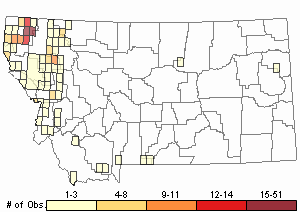
Recency
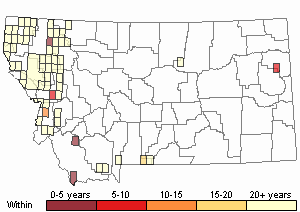
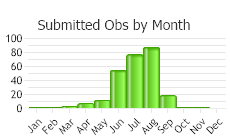
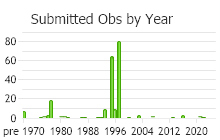
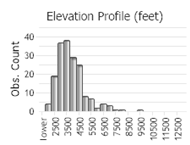 (Observations spanning multiple months or years are excluded from time charts)
(Observations spanning multiple months or years are excluded from time charts)
Habitat
Rock (FNA 2014), soil and humus, often relatively dry and disturbed sites (Elliott 2016). Elevation: 0-11,800 feet (FNA 2014).
Reproductive Characteristics
Dioicous. Seta deep red (Crum and Anderson et al. 1981), 10-20 mm tall. Capsule tilting to level, bowed, 2 mm in length (FNA 2014).
Stewardship Responsibility
References
- Literature Cited AboveLegend:
 View Online Publication
View Online Publication Crum, H.A. and L.E. Anderson. 1981. Mosses of Eastern North America. 2 volumes. Columbia University Press, New York. 1328 pp.
Crum, H.A. and L.E. Anderson. 1981. Mosses of Eastern North America. 2 volumes. Columbia University Press, New York. 1328 pp. Elliott, J.C. and A.K. Pipp. 2018. A Checklist of Montana Mosses (1880-2018). Updated 3 January, 2020. Montana Natural Heritage Program, Helena, Montana. 73 pp.
Elliott, J.C. and A.K. Pipp. 2018. A Checklist of Montana Mosses (1880-2018). Updated 3 January, 2020. Montana Natural Heritage Program, Helena, Montana. 73 pp. Flora of North America Editorial Committee, eds. 2014. Flora of North America North of Mexico. Volume 28. Bryophytes: Mosses, Part 2. Oxford University Press, Inc., NY. xxi + 702 pp.
Flora of North America Editorial Committee, eds. 2014. Flora of North America North of Mexico. Volume 28. Bryophytes: Mosses, Part 2. Oxford University Press, Inc., NY. xxi + 702 pp. Lawton, E. 1971. Moss Flora of the Pacific Northwest. Hattori Botanical Laboratory. Japan: Yamabuki-cho, Shinjuku-ku, Tokyo. 362 pages plus appendices.
Lawton, E. 1971. Moss Flora of the Pacific Northwest. Hattori Botanical Laboratory. Japan: Yamabuki-cho, Shinjuku-ku, Tokyo. 362 pages plus appendices. Vitt, D. J. Marsh, and R. Bovey. 1988. Mosses, Lichens & Ferns of Northwest North America. Seattle, WA: University of Washington Press. 296 p.
Vitt, D. J. Marsh, and R. Bovey. 1988. Mosses, Lichens & Ferns of Northwest North America. Seattle, WA: University of Washington Press. 296 p.
- Additional ReferencesLegend:
 View Online Publication
View Online Publication
Do you know of a citation we're missing? Aho, Ken Andrew. 2006. Alpine and Cliff Ecosystems in the North-Central Rocky Mountains. Ph.D. Dissertation. Bozeman, Montana: Montana State University. 343 p.
Aho, Ken Andrew. 2006. Alpine and Cliff Ecosystems in the North-Central Rocky Mountains. Ph.D. Dissertation. Bozeman, Montana: Montana State University. 343 p. Elliot, J. C. 1993. Second checklist of Montana mosses. Unpublished report. U.S. Forest Service, Region 1. Missoula, MT. 45 pp.
Elliot, J. C. 1993. Second checklist of Montana mosses. Unpublished report. U.S. Forest Service, Region 1. Missoula, MT. 45 pp. Lawton, E. 1971. Keys for the Identification of the Mosses on the Pacific Northwest. Reprinted from 'Moss Flora of the Pacific Northwest'. Published as Supplement No. 2 of the Journal of the Hattori Botanical Laboratory. Nichinan, Miyazaki, Japan. 66 pp.
Lawton, E. 1971. Keys for the Identification of the Mosses on the Pacific Northwest. Reprinted from 'Moss Flora of the Pacific Northwest'. Published as Supplement No. 2 of the Journal of the Hattori Botanical Laboratory. Nichinan, Miyazaki, Japan. 66 pp.
- Web Search Engines for Articles on "A Mat Moss"





